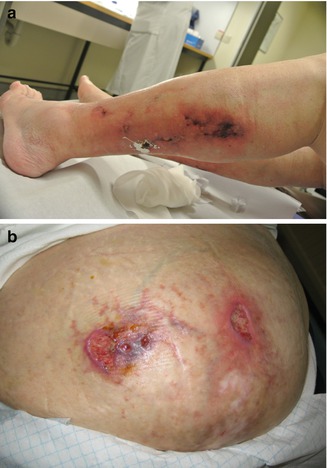Risk factors
Activating factors
Impaired vascular status
Hypovolemic shock, hypotension, vasoconstriction
Obesity
Cardiac insufficiency, infection, hyperviscosity
Diabetes mellitus
Local injury, injection, local pressure
Female
Hemostasis perturbations
Antivitamin K therapy
Elevated blood level of calcium and phosphate
Impaired bone mineralization
Hypercalcemia
Hyperphosphatemia
Hyperparathyroidy
Dialysis
The cutaneous involvement may be associated with systemic necrosis (myocardium, bowel, nervous system, pulmonary system, etc.).
Semiology: Painful and extensive skin necrosis, mainly associated with a livedoid aspect and often located in the abdomen and low extremities (Fig. 25.1a, b).

Fig. 25.1
Leg and abdominal involvement with ulceration and livedoid aspect
Biology: Presence or absence of hyperparathyroidism, coagulopathy, and disorders related to underlying conditions [3, 4].
Histology: One observe a transdifferentiation of the vascular muscle cells to osteoblastic-like cells causing extensive calcifications (vascular, muscular, and cutaneous involvements). Calcium deposition in the vascular walls and intraluminal thrombi can be found.
Stay updated, free articles. Join our Telegram channel

Full access? Get Clinical Tree








